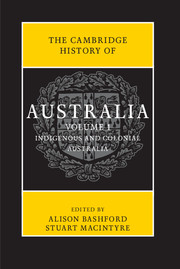Book contents
- Frontmatter
- Contents
- Abbreviations
- List of maps
- List of figures
- List of tables
- Notes on contributors
- Map
- Preface
- Introduction
- PART I
- PART II
- Further reading
- Chronology
- Index
- Frontmatter
- Contents
- Abbreviations
- List of maps
- List of figures
- List of tables
- Notes on contributors
- Map
- Preface
- Introduction
- PART I
- PART II
- 9 Religion
- 10 Culture and media
- 11 Science and medicine
- 12 Society and welfare
- 13 Gender and sexuality
- 14 Indigenous Australia
- 15 Class
- 16 The economy
- 17 Government, law and citizenship
- 18 Education
- 19 The environment
- 20 Travel and connections
- 21 Security
- 22 Australia, Britain and the British Commonwealth
- 23 Australia in the Asia-Pacfic region
- 24 The history anxiety
- Further reading
- Chronology
- Index
11 - Science and medicine
from PART II
Published online by Cambridge University Press: 05 November 2013
- Frontmatter
- Contents
- Abbreviations
- List of maps
- List of figures
- List of tables
- Notes on contributors
- Map
- Preface
- Introduction
- PART I
- PART II
- Further reading
- Chronology
- Index
- Frontmatter
- Contents
- Abbreviations
- List of maps
- List of figures
- List of tables
- Notes on contributors
- Map
- Preface
- Introduction
- PART I
- PART II
- 9 Religion
- 10 Culture and media
- 11 Science and medicine
- 12 Society and welfare
- 13 Gender and sexuality
- 14 Indigenous Australia
- 15 Class
- 16 The economy
- 17 Government, law and citizenship
- 18 Education
- 19 The environment
- 20 Travel and connections
- 21 Security
- 22 Australia, Britain and the British Commonwealth
- 23 Australia in the Asia-Pacfic region
- 24 The history anxiety
- Further reading
- Chronology
- Index
Summary
The Federation celebrations of January 1901 were muted for some. Bubonic plague – a quintessentially Old World disease – arrived in Sydney alongside the new century and the new nation. Infection was a devastating prospect for those at risk and their households and neighbours. But it was also a problem that tested the limits of Australian medical, scientific and governmental capacity and cooperation. How could Commonwealth responsibility for national quarantine – newly granted via the federal Constitution – be reconciled with the prevention of infectious disease, a State power derived from colonial laws? Although ancient, plague remained poorly understood and its appearance in New South Wales raised both research and epistemological questions. As doctors vied to understand and minimise the epidemic through colonial-era sanitary measures, the emerging laboratory sciences linked localised outbreaks to global research on microbes as the agents of disease. Epidemiology and bacteriology were integrated by the local Chief Medical Officer, John Ashburton Thompson, producing an internationally significant verification of a recent French theory: plague was caused by a bacterium harboured in fleas, carried by rats and only thus spread to humans.
The components of the plague episode played out repeatedly over the twentieth century. Who held responsibility for the health of Australians: not only for prevention and treatment, but its risks and costs? How were science, technology and medicine linked in the application of new knowledge and the pursuit of improvement? How and where was such knowledge generated, who was empowered to deploy it and who adjudicated its efficacy? Within the transnational orthodoxies of science and medicine, how unique were Australian experiences and enterprises? Health and medicine, and science and technology were social endeavours tightly tied to political structures. Shifting perceptions of individual, communal and governmental responsibility for health and useful scientific innovation reflected changing expectations and experiences of citizenship.
- Type
- Chapter
- Information
- The Cambridge History of Australia , pp. 263 - 283Publisher: Cambridge University PressPrint publication year: 2013
- 1
- Cited by



